SERP Analysis
What is it?
Search Engine Results Page or SERP analysis is the examination of the top-ranking pages within search engine results. Traditionally, this analysis is used to gain an understating of ranking content so SEO teams can establish if—and how—the websites on which they work can rank within that landscape.
To take an example, lets have a look at the results for ‘best high street foundations’:
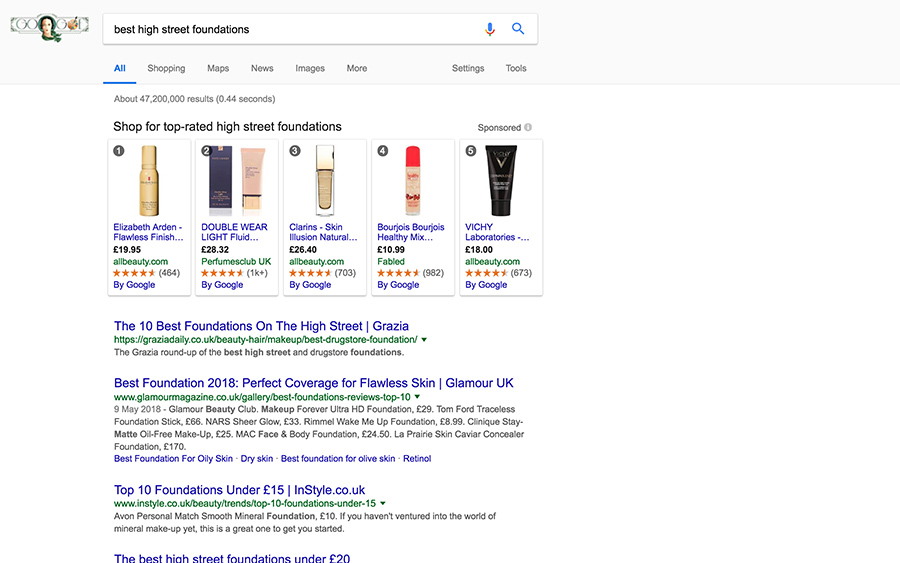
The SERPs here are dominated by publishers, and quite rightly so; the searcher is looking for an impartial view and so the organic listings reflect that.
A traditional SEO approach would likely look at this results page in one of two ways:
- They may conclude that there’s no opportunity for a brand to out-rank, as relevance is lacking
- They may consider suggesting sinking ill-informed budget into a content strategy designed to compete with publishers. The downside is that brands can rarely be truly impartial, and so producing editorial designed to rank in this instance would be budget down the drain
But what about passing these insights through to PR? There are multiple opportunities for savvy PR teams to use this analysis to build really robust data-led media lists, designed to get their products maximum exposure.
How can these insights be used by PR teams?
Let’s say you head up PR at Maybelline. You’re infinitely confident in your product, and you’re looking to ensure that your foundations are consistently covered by the digital press.
SERP analysis of impartial terms is a goldmine of opportunity for PR.
Here are a few ways your PR team might want to use this analysis:
Identifying old content, and suggesting an update to the author
Within the SERPs, some results will have a publish date attributed to them:
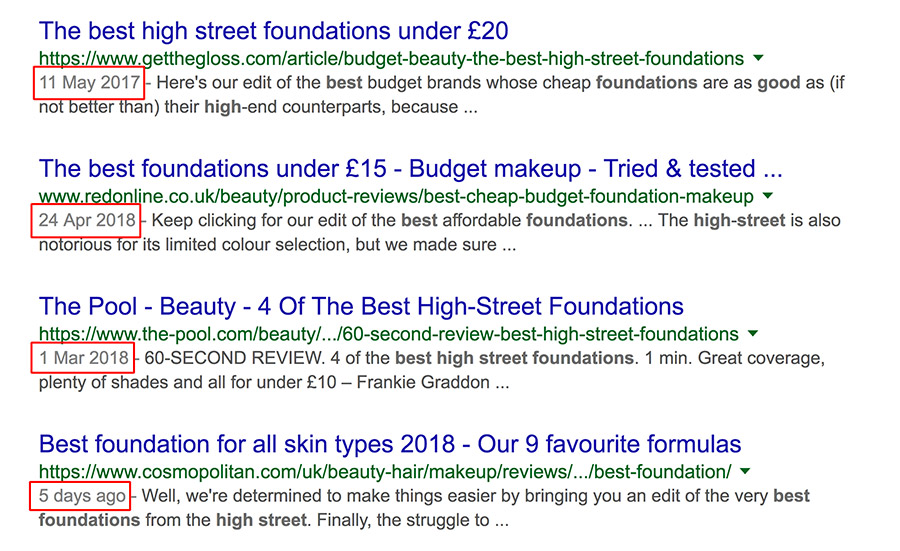
Immediately you can see that Get the Gloss have not updated their feature since last year, whereas their competitor publications have far more recent coverage.
The opportunity here is to reach out to publishers of outdated content, offering them information on your new products as a means of keeping their content current.
It’s an easy in and provides value to both you and the publisher.
Building a digital media list using ranking authors
By identifying the authors who rank for relevant impartial terms, you can quickly build out a highly relevant pool of reviewers with whom you can check in on a quarterly basis during new product launches.
You’ll have your little black book already, but by working with journalists who write content that ranks, you’re ensuring your coverage has long term exposure, rather than gaining coverage which is banished from the homepage after the first day.
By working with publishers who rank, you can develop an evergreen PR strategy.
Not only that, but you know that if the articles in which you’re featured are ranking well, you’ll be able to drive consistent referral traffic back to product pages. By tracking on-page conversions you can easily turn this activity into something clearly measurable which can be tied back to revenue.
Publication and Author Analysis
The need to keep delivering links from new domains means that SEOs are under constant pressure to make and develop new contacts.
At Builtvisible, each time we work with a new client we do something called publication and author analysis as part of our digital PR strategy. This helps us to avoid repeatedly reaching out to the same publications for every campaign , by telling us the following about the publishers within our client’s niche:
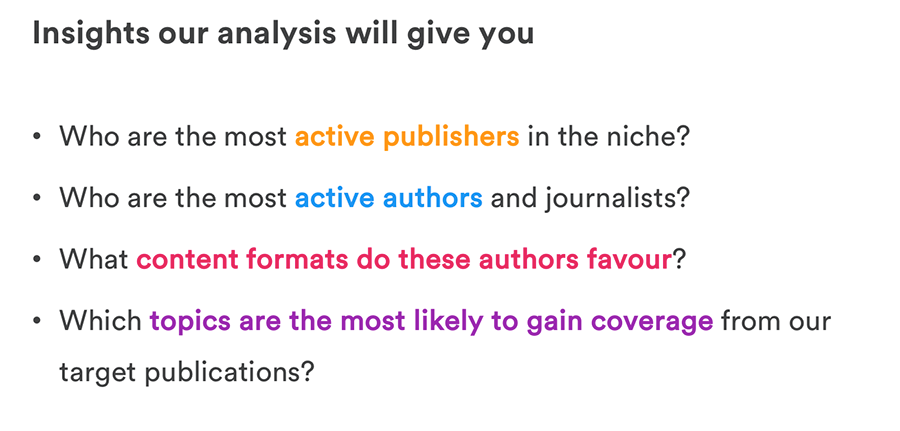
This data gives us everything we need to build a fresh media list and build a campaign that we know is going to get coverage. It’s an incredibly powerful piece of analysis!
How can these insights be used by PR teams?
Hopefully this is obvious, but the data we collect to build our outreach lists is what PR strategy dreams are made of!
As well as building out reliable and highly relevant media lists for our campaigns, we can help to feed the trends that we uncover to our client’s PR teams, who in turn use these insights to digital strategies of their own.
On-site Analytics
Our analytics offering at Builtvisible has grown to a point where it influences much of what we do on the content team.
Investing in data collection so you’re able to confidently track on-site behaviour and translate this into PR activity is (again) a goldmine of highly useful data.
What data should you be collecting?
Analytics strategy is so advanced that it can essentially be tailored to measure most of what you need, but to give you an idea of how we use it to feed PR campaigns here’s a bit of inspiration in terms of what you might like to measure:
- The ability of a page to funnel users through to more overtly commercial pages
- Rate of social interaction
- The frequency of mailing list sign-ups from editorial sections of a site
- The impact of video content on conversion rate
That’s a tiny range—the potential is limitless if you have dedicated analytics spend. Understanding the on-site behaviour of consumers who have arrived at a website due to PR efforts can be invaluable when building future PR strategy.
By linking off-site and on-site strategy to ensure a seamless consumer experience, you can better measure the impact of your PR activity, whilst also being able to use your understanding of consumers to ensure future PR campaigns convert better.
Content Gap Analysis… but not how you might think!
Content gap analysis is traditionally used to help SEOs spot gaps within their onsite content. Simply put, by mapping content to keywords that your SEO strategy aims to target you’re then able to identify where the opportunities for content creation are, and how you can create new content to increase your visibility.
Where this gets interesting for PR teams, is performing this same analysis for the publications in which they want to gain coverage.
The process I’m suggesting looks a little like this:
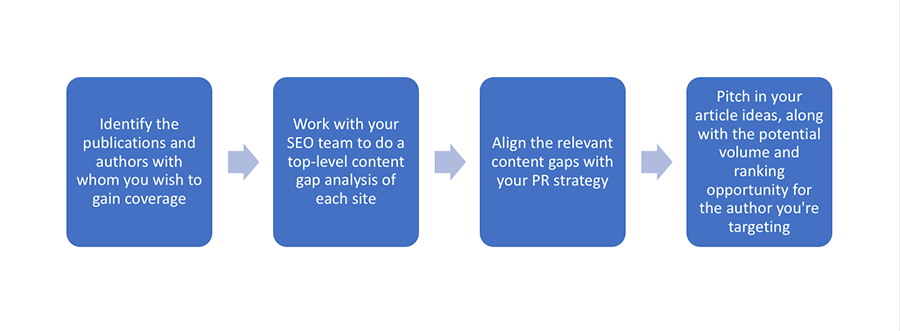
Why does it work?
Journalists care about the performance of their content. If they are consistently creating content which performs well and drives traffic to the publications they write for, it ultimately helps them get more work!
If you’re able to get in touch with a writer from the Financial Times, for example, to offer 10 fresh editorial ideas that i) have significant search volume, ii) have not yet been covered by their publication and iii) have the potential to rank—that is going to make for a far more attractive proposition than something more self-serving.
You’re essentially doing an important part of their job for them, demonstrating how the content you’re providing them with will help them perform well. If your suggestions are brand-aligned, engaging and high-volume, it’s a win-win scenario and a brilliant way to use content gap analysis to bolster your press approaches!
Seasonal Press Analysis
One piece of research we conduct upon starting a content campaign can be used to identify seasonal trends and inform PR teams when their products are being covered in the press.
You can see an example insight below:
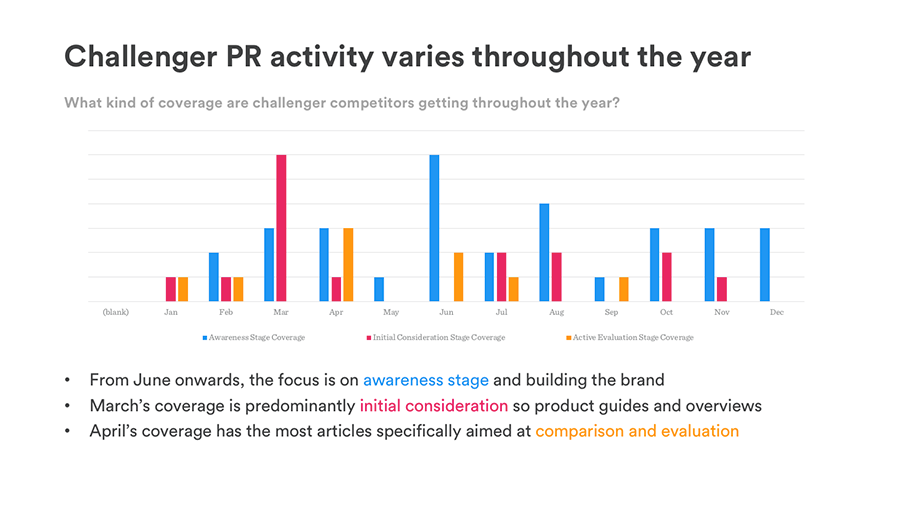
The above was for a financial client who was looking to launch a new product. They wanted to build a PR strategy based on when different elements of their product were being talked about in the press.
By translating their consumer funnel into content topics and monitoring how and where these topics were posted on top-tier publications throughout the year, we were able to give our PR colleagues the following guidance:
- A steer on when to release product-heavy campaigns in order to stay ahead of the curve
- Guidance on when to produce ‘awareness’ content to get the most cut through
- Exposure to how challengers are gaining coverage, in comparison to the bigger players
Now from an SEO perspective we use this data in two ways. Firstly, it helps us frame our editorial calendars. Secondly it helps us build seasonal link building strategies. From a PR perspective yet again, this analysis added huge value to PR strategy.
It’s not always about understanding what will get traction, sometimes using data to understand when you will receive campaign pick up can be just as powerful.
Link Data
Last but not least it goes without saying that understanding how, and from where, a website is building links can feed some hugely valuable data into PR strategy.
Many PR teams are likely using this data already, but if not here’s a brief overview of the data you should be requesting and how you can use it:
Why are people linking?
If you only ask one question, make it this one!
There could be multiple reasons that a website is choosing to link over to your site and understanding how and why links are coming through to your site is invaluable from a PR perspective. For example, if you see that most sites are linking through to product pages that gives you a pretty good indication that product-led PR campaigns are likely to get traction.
Likewise, if you see that multiple publications are linking to resources on your site, that’s another clear indication that guide content is going to prove popular with publishers.
Where are the highest quality links being driven?
Understanding where the big players are linking can tell you a lot about the opportunities you can readily exploit. Asking for a simple overview, akin to the below, can give you a beginner’s view into how publishers and influencers are naturally covering your brand.
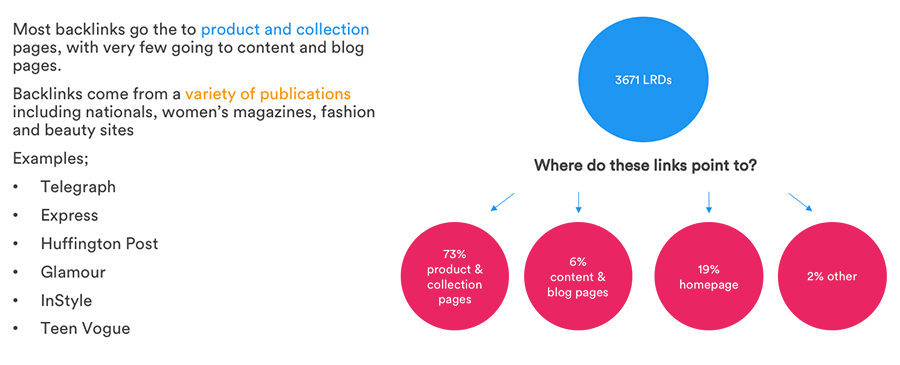
Using data from SEO, can work wonders on the performance of PR
SEO and PR combining forces to create data-led campaigns is an untapped opportunity for many brands. Outside of the simpler collaborations like mopping up PR coverage with link reclamation, or helping PRs to build links, there are long-term collaborations that can have a lasting impact on the growth of PR as a digital channel.
By sharing data and pivoting how it’s used for PR purposes the two teams can work together to become a tangible revenue driver.